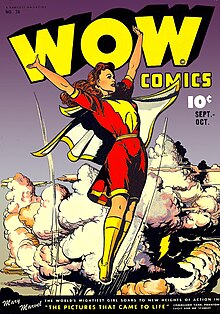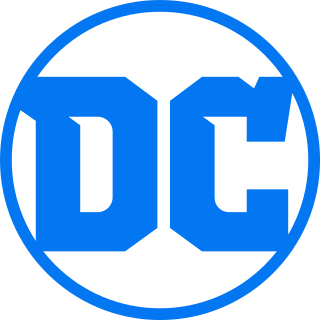
DC Comics, Inc. is an American comic book publisher and the flagship unit of DC Entertainment, a subsidiary of Warner Bros. Discovery.
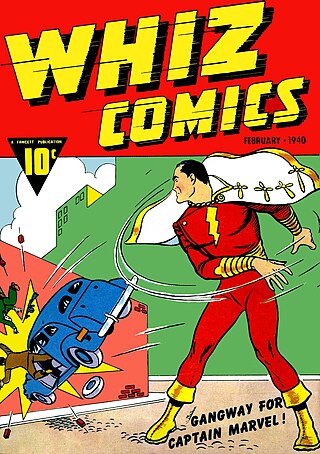
A superhero or superheroine is a stock character who typically possesses superpowers or abilities beyond those of ordinary people, is frequently costumed concealing their identity, and fits the role of the hero; typically using their powers to help the world become a better place, or dedicating themselves to protecting the public and fighting crime. Superhero fiction is the genre of fiction that is centered on such characters, especially, since the 1930s, in American comic books, as well as in Japanese media.

The Silver Age of Comic Books was a period of artistic advancement and widespread commercial success in mainstream American comic books, predominantly those featuring the superhero archetype. Following the Golden Age of Comic Books, the Silver Age is considered to cover the period from 1956 to 1970, and was succeeded by the Bronze Age.

The Justice League, or Justice League of America (JLA), is a group of superheroes appearing in American comic books published by DC Comics. The team first appeared in The Brave and the Bold #28. The team was conceived by writer Gardner Fox as a revival of the Justice Society of America, a similar team from DC Comics from the 1940s which had been pulled out of print due to a decline in sales.
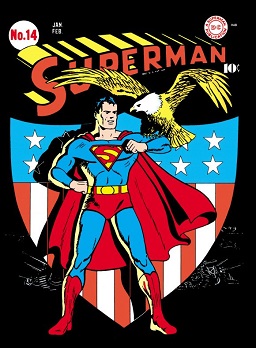
The Golden Age of Comic Books describes an era in the history of American comic books from 1938 to 1956. During this time, modern comic books were first published and rapidly increased in popularity. The superhero archetype was created and many well-known characters were introduced, including Superman, Batman, Robin, Captain Marvel, Captain America, and Wonder Woman.

An American comic book is a thin periodical originating in the United States, on average 32 pages, containing comics. While the form originated in 1933, American comic books first gained popularity after the 1938 publication of Action Comics, which included the debut of the superhero Superman. This was followed by a superhero boom that lasted until the end of World War II. After the war, while superheroes were marginalized, the comic book industry rapidly expanded and genres such as horror, crime, science fiction and romance became popular. The 1950s saw a gradual decline, due to a shift away from print media in the wake of television and the impact of the Comics Code Authority. The late 1950s and the 1960s saw a superhero revival and superheroes remained the dominant character archetype throughout the late 20th century into the 21st century.

Nelson Alexander Ross is an American comic book writer and artist known primarily for his painted interiors, covers, and design work. He first became known with the 1994 miniseries Marvels, on which he collaborated with writer Kurt Busiek for Marvel Comics. He has since done a variety of projects for both Marvel and DC Comics, such as the 1996 miniseries Kingdom Come, which he also cowrote. Since then he has done covers and character designs for Busiek's series Astro City, and various projects for Dynamite Entertainment. His feature film work includes concept and narrative art for Spider-Man (2002) and Spider-Man 2 (2004), and DVD packaging art for the M. Night Shyamalan film Unbreakable (2000). He has done covers for TV Guide, promotional artwork for the Academy Awards, posters and packaging design for video games, and his renditions of superheroes have been merchandised as action figures.

Bulletman and Bulletgirl are fictional superheros originally published by Fawcett Comics.
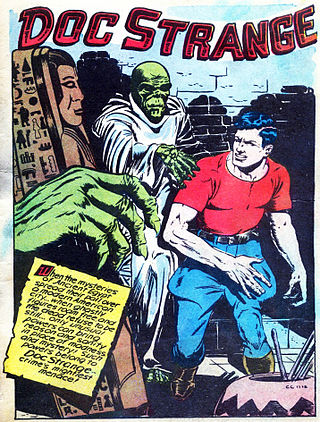
Doc Strange is a Golden Age comic book superhero who originally appeared in Thrilling Comics #1 in February 1940. The character continued in Thrilling Comics until issue #64. He also appeared in America's Best Comics #1-23 and 27.
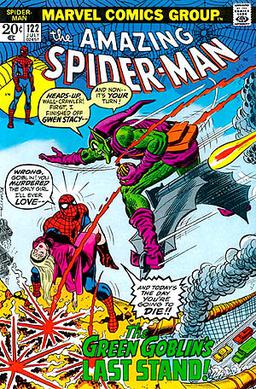
The Bronze Age of Comic Books is an informal name for a period in the history of American superhero comic books, usually said to run from 1970 to 1985. It follows the Silver Age of Comic Books and is followed by the Modern Age of Comic Books.

Whiz Comics was an anthology comic book series published by former American comic book publishing company, Fawcett Publications between February 1940 until June 1953. It is widely known for being the comic run in which hugely popular superhero character Captain Marvel (Shazam) made his debut.

Uncle Sam is a superhero appearing in American comic books published by DC Comics. Based on the national personification of the United States, Uncle Sam, the character first appeared in National Comics #1 and was created by Will Eisner.

Wonder Man is a fictional superhero created by American cartoonist Will Eisner, whose only appearance was in the comic book Wonder Comics #1. The character is of some historical significance due to a lawsuit that resulted from his only appearance.
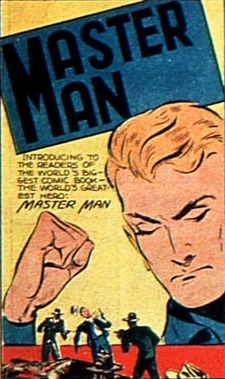
Master Man is a fictional character created during the 1930s to 1940s period referred to as the Golden Age of Comic Books. A superhero, the character's exact creator is uncertain: his first story, in Fawcett Comics' Master Comics #1, was drawn by Newt Alfred, but that issue's cover was drawn by Harry Fiske. The leader character in the anthology Master Comics, he was described as:
"...the world's greatest hero: Master Man! Stronger than untamed horses! Swifter than raging winds! Braver than mighty lions! Wiser than wisdom, kind as Galahad is Master Man, the wonder of the world! As a boy, young Master Man was weak until a wise old doctor gave the youth a magic capsule, full of vitamins, containing every source of energy known to man! The boy becomes the strongest man on earth! Upon the highest mountain peak he built a solid castle made of solid rock! From there he sees all evil in the world and races to destroy it instantly!"

Comic Cavalcade was an anthology comic book published by DC Comics from 1942 to 1954.

Captain Flag is a superhero created by MLJ Comics' writer Joe Blair and artist Lin Streeter. He first appeared in September 1941, in issue #16 of Blue Ribbon Comics. He continued until the last issue, Blue Ribbon Comics #22.

"Professor Supermind and Son" was a comic book feature that appeared in issues #60–71 of Dell Comics' Popular Comics. The strip was drawn by Maurice Kashuba.

Crimson Avenger is a superhero published by DC Comics. He first appeared in Detective Comics #20. He is the first superhero and costume hero published in Detective Comics. He preceded Batman, and appeared in the same year after Action Comics #1 debuted characters like Superman, which led to the Golden Age of Comic Books. He is sometimes depicted as one of the first masked heroes within the fictional DC Universe. He is also known as a founding member of DC's second depicted superhero team, Seven Soldiers of Victory. After his death, his legacy name lives on other characters.

Amazing-Man is a comic book superhero whose adventures were published by Centaur Publications during the 1930s to 1940s in the Golden Age of Comic Books. Historians credit his creation variously to writer-artist Bill Everett or to Everett together with Centaur art director Lloyd Jacquet. Amazing-Man first appeared in Amazing-Man Comics #5.

Superhero fiction is a subgenre of speculative fiction examining the adventures, personalities and ethics of costumed crime fighters known as superheroes, who often possess superhuman powers and battle similarly powered criminals known as supervillains. The genre primarily falls between hard fantasy and soft science fiction in the spectrum of scientific realism. It is most commonly associated with American comic books, though it has expanded into other media through adaptations and original works.
